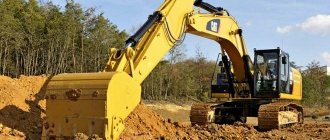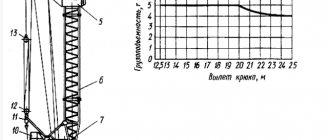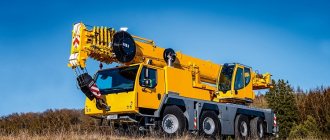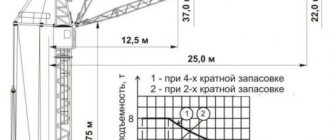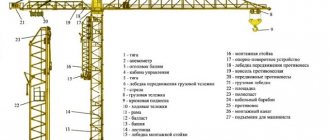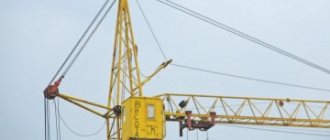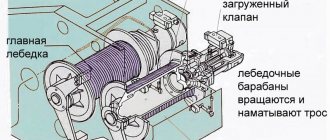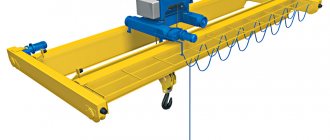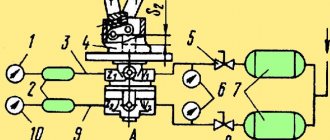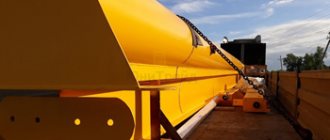Preparation
Tower cranes are brought to the construction site in disassembled form, then workers assemble them on site. The structures are heavy, so the site must be prepared before installation.
The mechanism consists of the following parts:
- Tower.
- Cabin designed for the driver.
- Console. It is necessary for counterbalance.
- Arrow. Load-lifting mechanism.
First, the place where the unit will stand is leveled. To make the structure more stable, the surface is filled with concrete. Grounding is required and electricity is supplied to the site.
You can install a construction crane using a truck crane, but it must be delivered to the site. Convenient access routes to the construction site should be determined in advance.
Tower crane installation (video)
Surely not a single modern construction can now be done without lifting mechanisms, and sometimes they reach colossal sizes. For example, tower cranes, which can easily lift loads to the height of a 20-story building. Often, seeing such a giant, the first thing that comes to mind is the question of how a tower crane is assembled, because it is not entirely transported around the city, from one object under construction to another.
Preparatory work
So, the crane is delivered in parts on special tractors and they begin to assemble it on site. There are quite a few methods for installing a crane, but they all begin with the preparation of a special site on which the entire assembly process will take place. After the site itself has been cleared, electrical cables are supplied to it for external power supply of the future crane.
At the same time, in the prepared area, special rail tracks are installed and prepared for use, along which the crane itself will subsequently move.
Such paths are necessary in cases where the crane boom span is not able to cover the entire required area on the construction site, and crane rails often become necessary during the process of dismantling the crane, especially in cases where conditions do not allow dismantling on site and the crane must be removed from the construction site .
How to install a faucet?
After the preparatory work is completed, the installation of the tower crane begins. A very important point in the assembly process is compliance with all regulations and maintaining the technological process, because the further operation of the crane depends on the quality of the assembly.
Only high-quality work during the installation process will help to avoid the collapse of the crane on the object under construction or on the adjacent territory, which will undoubtedly lead to a local industrial disaster.
It is worth noting that the fall of tower cranes is also possible at the dismantling stage, and it will often be caused by poor-quality installation work.
So, currently there are several options for installing a crane, the final choice of which depends on the conditions of the construction zone, as well as on the model of the crane itself. As a rule, when choosing a crane assembly method, specialists use the relationship between the nominal values of the boom length and the required height of the future tower of the crane structure as determining parameters. The time factor is also taken into account, in technical language designated as “duration of parking”
The fastest and least labor-intensive method is to assemble the tower crane without disassembling it into separate parts.
Unfortunately, this method requires the most suitable conditions and freedom of action in terms of territory on the construction site, since the crane with the folded boom lies on the ground almost its entire length, and then rises using its own installation winches.
This method allows not only to reduce labor costs for the installation team, but also to significantly reduce the time allotted for preparatory work. Moreover, due to the fact that the crane does not have to be disassembled and reassembled again, the percentage of loss of small parts is reduced.
https://www.youtube.com/watch?v=9m-_AzDxmjc
A tower crane, which has a rotating column, is relatively simple to install, as it allows you to mount the crane tower with a folded boom using its own lifting mechanisms, which is called a jib pulley. Delivery and unloading for such a crane is carried out using a crawler or wheeled truck crane.
The most common method is to mount a tower crane when installing a stationary mast. In this case, after preparation, all individual parts of the structure are placed on the construction site in the required sequence, and then the assembly of the crane begins according to the type of constructor. One of the most obvious advantages in this method is the almost complete absence of special conditions and requirements for the construction site, and the space required to assemble the crane is small.
On the other hand, this method requires a lot of labor from the people involved in the installation of the tower crane, since the work is often carried out at high heights, which often exceed the height of the tower itself. It is also often necessary to use additional mechanisms and special fastenings for a tower crane in order to ensure the reliability of the structure as a whole.
The tallest cranes are usually installed using several different methods at once, as well as using additional equipment.
As a rule, the installation of a tower crane in the first stages is carried out through a remote control panel for electrical circuits; such assembly is carried out in order to avoid industrial accidents. Having installed the tower on the mounting stand, lift the spacers, and then install and secure the block fencing.
The next step is to install the mounting rack into working position, and only after that a special trolley is brought onto the crane tracks, which helps secure the running frame to the tracks. A counterweight is attached to the running frame on the platform, and then the head of the crane boom is suspended on a special cargo rope.
Then the crane tower is raised, and the head section of the boom is connected to the main one.
At the last stage, assembling the tower crane includes raising the booms and connecting the power supply from the remote control to the control panel, which is located in the crane cabin.
After this, all the necessary lighting devices are connected to allow work in conditions of limited visibility, and the installation of the crane is completed.
After the mechanical part of the assembly is completed, all systems are checked and checked for compliance with installation standards established by the state. Only after all tests are completed is the tower crane allowed to work by the installation team.
And this is how the tower crane installation looks like in the video:
Source: https://asptech.ru/krany/bashennye-krany/montazh-bashennogo-krana-video/
How to install taps
Installation of cranes is a fairly simple matter that does not require much time and effort. First, workers build a pedestal; it is necessary to install the mechanism. A tower structure is installed on it and secured securely.
An auxiliary crane is used to move the slewing support mechanism into place and fix it in place. After this, workers move on to building up the remaining parts of the structure. This is a tower, a rotating platform, a device for raising and lowering a load, a mechanism for changing the boom reach.
The individual sections of the lift are moved and assembled using the mechanism's own boom. This allows you to quickly increase the height of the device.
The work uses a mounting device, which is a single frame structure. It differs in that it has a removable front part. The mounting device is necessary both for assembly and further operation of the mechanism.
The assembly of the tower crane is carried out using the control panel of the mounting structure, and an auxiliary remote control panel is also used in the work. Along with assembling the device, workers can install support cranes.
Industrial lifting devices at a construction site can reduce the time required to complete work. The house under construction will be completed in just a few weeks.
How to install new sections on a crane
If a construction site needs not a standard, but a taller crane, the work is done a little differently. First, a concrete slab is installed, which becomes a reliable foundation. The first section of the crane is tightly mounted into the slab. The next sectional element, called the mounting frame or “telescope,” is lifted by a truck crane.
This second section is slightly larger in size than the first and subsequent ones. The boom and operator's cabin are attached to it.
Now it becomes possible to consistently increase the height of the entire structure. While driving the machine, the operator assembles his future crane himself. Workers place the next structure inside the second, auxiliary section. After this, each new section is lifted to the required height using winches and secured. This continues until the height of the tower crane reaches the specified value. If in the future the tap needs to be grown a little more, the whole process is repeated.
Checking correct installation
Regular checks and preventive maintenance are the key to trouble-free operation of the mechanism. Wear and deterioration can be observed on mechanisms that have been in use for many years. Under extreme loads, such equipment fails.
An extraordinary technical inspection is necessary after installing the lifting device at a new workplace. During the technical inspection, the operation of mechanical and electrical equipment, safety devices, brake systems and control units, as well as alarms is checked.
During a full inspection, the following will be checked:
- What condition is the metal structure in? The condition of its welded joints is taken into account. Experts look for tears, deformations, rust and other damage. They check the condition of the cabins, stairs, platforms and guardrails.
- The technical condition of the hook and suspension parts, taking into account the degree of their wear.
- How the cargo ropes are secured, their condition.
- Appearance of blocks and fastening elements. Suspension components must be checked.
- Grounding of an electric tap powered from an external network.
- The relationship between the counterweight mass and the ballasts of a tower crane. The obtained values are compared with the numbers indicated in the passport.
When installing cranes and carrying out inspections, they are guided by the information specified in the instructions. The document is drawn up by the manufacturer of the tower mechanism.
How to assemble a tower crane - Construction Blog
Today, the cranes used in the construction of modern skyscrapers cannot be transported fully assembled. They are delivered to the construction site disassembled (equipment elements are transported using tractors).
To assemble this machine, first prepare a place convenient for installation and put it in order. Then a source of electricity is installed (or cables are laid from it), and rails are installed to ensure the movement of the crane during its operation (required if the construction radius exceeds the length of the boom).
Introduction
In ancient times, the only lifting means were rope and the physical strength of people, which is probably why builders could not boast of erecting high-rise buildings.
Assembly steps
Assembly order:
- Installation of the turntable and running frame.
- Installation of a portal with a tower. Cabin installation.
- Lifting the crane and assembling the boom.
If you look at the video of how a construction crane is assembled, you can see that at the first stage the work is carried out using two truck cranes. This is a fairly compact and mobile equipment that can drive to any place on the construction site. One crane brings the trolley under the supports on the rail tracks, and the second installs the turntable. The truck crane also installs reinforced concrete blocks, which act as counterweights. If there are railway tracks in close proximity to the site, it may be more appropriate to use a railway crane.
The portal and tower are also mounted using a truck crane. He also lifts the driver's cabin up. The cabins are divided into two types - for work at a height of up to 20 m and high-altitude, for work at a height above 20 m. The tower is assembled into several sections in height, after which a special “telescopic section” is installed, due to which the rest will subsequently be mounted.
The connection and fastening of the turntable truss and portal units is done manually using hinged bolts, which are secured using a regular sledgehammer. Also, manual connection and adjustment of electrical equipment and fixing (reserving) of steel ropes are carried out.
At the same time, the boom is being assembled. It consists of metal lattice sections. Assembly takes place on the ground, in a horizontal position. The boom is installed using a truck crane. After this, at the final stage of work, you can see how the tower crane assembles itself. The boom picks up one section and pulls it towards the tower until it is inside the telescopic section. After fixing the hinged bolts, the “telescope” is raised to the height of the section and the cycle is repeated. Thus, the height of the tower is increased to the required one. The process ends with testing and official acceptance of the equipment into operation.
Precautions during operation
The weight of the crane can be more than 50 tons. Therefore, the processes of its assembly and transportation are strictly regulated.
During the installation and dismantling of a tower crane, the following is prohibited:
- Do not allow unauthorized persons to be in the work area. To do this, the construction site is fenced off and only workers directly involved in the process are allowed to access the crane parts.
- Lifting and lowering people with a crane. This prohibition entails another - to be on raised or lowered structures. No matter how good a view the operator’s cabin provides, it is easy not to notice a person on a three-meter section being lifted. It is also prohibited to carry out any manipulations with suspended structures. If something needs to be corrected, the load should be lowered completely to the ground and only handled after it has come to a complete stop.
- Be under lowered or raised structures.
- Leave lifted loads and metal structures hanging unattended. This is especially dangerous in strong winds, but even in calm weather it increases the load on the crane and can lead to accidents.
- Throwing objects from a height. Loads can only be lowered using the crane hook. Small items, garbage, etc. are taken down with employees.
- Carry out work during thunderstorms, fog, ice and wind speeds of more than 12.4 m/s (6 points).
- Use for any manipulations cables, ropes and slings that have been spliced. If the rope is broken, it is written off or used for other, less dangerous work.
- Carry out installation and dismantling work when the voltage drop in the electrical network is more than 10%.
During transportation it is also necessary to comply with a number of requirements. Elements of a tower crane are, as a rule, oversized loads. Therefore, it is necessary to ensure that the dimensions of road trains do not exceed the maximum permissible values, taking into account the bridges, overpasses and tunnels that have to be passed. The load must be rigidly secured in the longitudinal and transverse directions and marked in accordance with traffic regulations. Transportation is carried out after obtaining a permit and accompanied by a traffic police vehicle. During loading and unloading operations, it is necessary to use rope ropes to prevent the movement and rotation of parts.
Preparing for installation
Installation of any heavy special equipment is possible only on a prepared site. Therefore, before you find out how a crane is assembled at a construction site, you should consider the preparatory work. The site must be leveled and cleared of construction debris, etc., and fenced in accordance with the rules. If we are talking about rail technology, then first, crane tracks are laid on a pre-concreted area (ground or above ground, depending on the size of the crane and construction conditions). The rails are equipped with movement limiters on both sides.
All manipulations with parts are carried out with a truck crane or, if there are railway tracks in the installation area, with a railway crane. Upon completion of installation, all mechanisms are run in, after which the crane is tested under load . Only after this can the equipment be put into operation.
